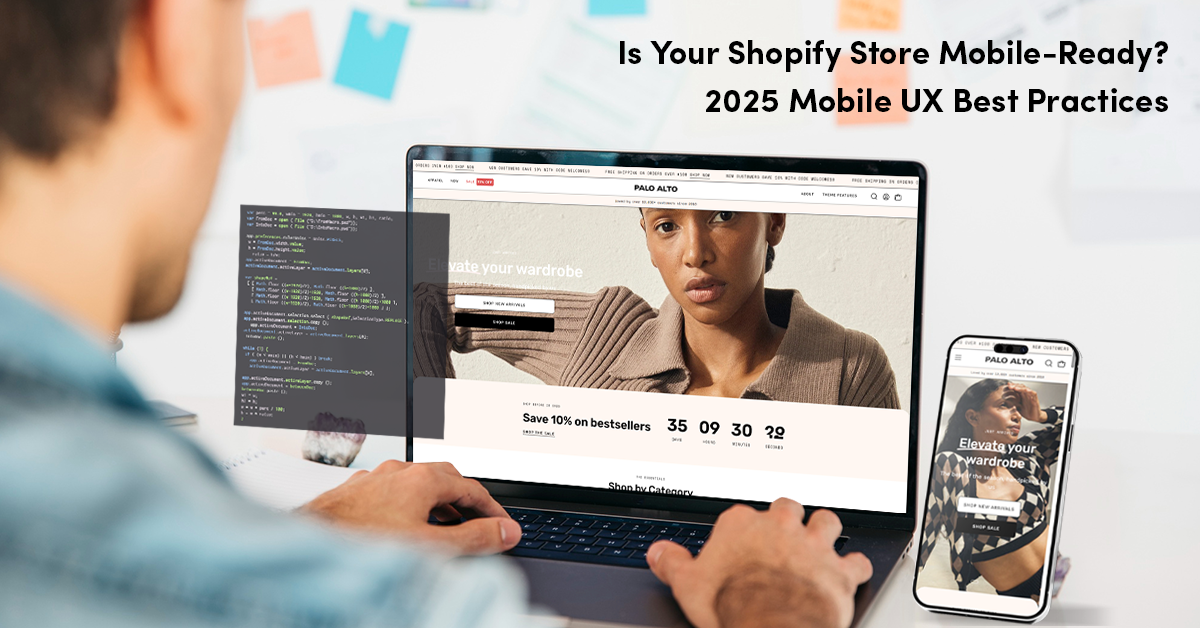Digitization is a non-negotiable in the current competitive market, especially for D2C brands. If you need to know how to build a Shopify store, we’re here to help. By following the Shopify guide for beginners, you can learn how to convert your idea into a profitable Shopify store.
This guide covers how you can:
- Find what to sell online
- Set up your online business
- Launch your Shopify store
- Boost your sales & revenue
Choosing the right e-commerce platform
A decade ago, shopping meant going to the crowded streets or the popular shopping malls and walking around to find what you needed. Now, shopping means sitting in a pajamas, scrolling through different sites. The growing digitization and secure infrastructure have boosted online businesses for all types of digital companies.
Due to the growing demand and competition, choosing the right e-commerce platform is critical for the success of your digital business.
Shopify has risen above many e-commerce platforms, ranking as the 4th best e-commerce platform globally (source). Shopify offers a wide range of free and paid themes to help brands launch a standard Shopify store within 2-4 weeks; more complex stores may require additional time. Therefore, Shopify is ideal for brands looking for manageable competition and easy access to their target audience.
The pillars of a successful e-commerce brand are laid before the brand is launched online. Thus, we will discuss a few key steps you need to take before launching your store to help you manage your business smoothly.
Do R&D to find your niche.
The first question you must ask yourself before launching the store is: What do you want to sell? You might know what you want to sell. But the real question is, what niche do you want to cater to?
‘I want to start a fashion brand’ isn’t enough! You need to be more specific. Do you want to sell to men or women? Kids or adults? Do you want to offer fast fashion or handmade apparel? Create casual or formal clothes?
Understanding your niche helps you create a better marketing strategy, find relevant keywords for SEO ranking, and narrow down your competition.
You can find your niche by focusing on:
- Your passion for a product
- Customer’s pain points
- Degrees of competition
- The market gap and trends for certain products
- Competitor’s weakness
- Gather customer feedback
Having a niche helps you understand your buyer’s persona, enabling you to build a user-friendly store design and create an effective marketing strategy from the outset.
Analyze the competition for performance gaps.
The success of your Shopify store depends on how effectively you can manage competition. Beating the competition isn’t about doing better than them, but also about what they aren’t doing. Identify a market with a rise in demand but limited supply, resulting in relatively low competition.
You must closely analyze a few competitors based on their sales, SEO, customer service, and marketing. Use tools like Ahrefs, SEMrush, and Shopify store tracker for competitive analysis. Identify the gaps in their performance and how you can leverage them into your unique selling proposition (USP), especially if they relate to customer service.
Create your business model.
A business model is a comprehensive plan for all aspects of your e-commerce business. From filling up your inventory to managing shipping and revenue, your business model should outline everything about your e-commerce business.
The following are a few key points to focus on when creating a business model for your brand.
- Operations Management: Develop a plan for sourcing products for inventory and logistics for shipping. Choose whether to start as a local or global brand and set up the order processing and shipping system.
- Revenue management: Select a revenue model with multiple income streams to optimize profits. Some revenue models include direct sales, monthly packages, subscriptions, premium experience subscriptions, affiliate and third-party selling, and more.
- E-commerce Insurance: Protect Your Intellectual and Physical Property with E-commerce Insurance. The insurance provides coverage in the event of a cyber breach, settlements, transit damage, and general liability.
- Marketing strategy: Your marketing strategies should highlight how you can effectively reach and convert your customers into loyal ones through attractive offers and loyalty programs.
- Pricing strategy: Set a price based on your target audience’s profile and competition. You can opt for fixed, tiered, or dynamic pricing based on your needs.
Set up Shopify Store & Domain
A Shopify Store is no different from other e-commerce sites; it helps users choose a product, select a delivery option, and make a payment. Therefore, you must set up your profile and integrate the necessary tools to provide a seamless user experience and boost your conversion rate. The following is a guide on how to build a Shopify Store.
Create a Shopify account.
Shopify offers four plans tailored to different business sizes and needs. These plans provide various features to support businesses of different sizes in their growth. The following are the types of Shopify accounts that you can open:
- Shopify Basic for solo entrepreneurs
- Shopify Grow for MSME businesses
- Shopify Advanced for large-scale businesses
- Shopify Plus for companies with unique needs and B2B models
You can take a free trial before choosing the best plan for your e-commerce company.
Choose a theme
A Shopify theme refers to the website’s layout. When choosing a theme, focus on the navigation layout, category pages, product pages, and page sections.
Most importantly, choose a theme that loads faster because 40% of users leave the website if it doesn’t in three seconds (source). Choosing a visually appealing, functional, and fast-loading theme improves user engagement and reduces bounce rates.
Buy a domain
Your domain is your digital identity. Therefore, you need to choose a domain that is easy to remember and spell. Choose a domain and its extension that is simplistic.
Add your products
When creating a product page, include a clear and SEO-friendly title, description, images, alt text, and videos. Compress the image and video files to reduce the loading speed.
Integrate support and marketing apps.
Create a user-friendly store by integrating diverse apps to upsell products related to customers’ needs, provide live customer support, create lucrative product bundles and offers, and more. You can enhance user satisfaction by integrating support and marketing apps.
Set up payment gateways & shipping options
Set up secure payment gateways to win over customers. Choose location-based payment gateways to personalize the shopping experience for the users and boost your conversion rate.
Choose the best Shipping apps, such as ShipStation, Shiprocket, and Post & DHL Shipping. It allows you to streamline your shipping through trusted shipping companies. You can choose local shipping companies based on the global target market.
Integrate all relevant pages.
Create and integrate other website pages, such as the About Us page, Policies Page, Product category pages, Contact Us page, and any other relevant pages to your business.
Create a user-centric store design
Shopify makes D2C ecommerce setup easier than ever, especially for those who don’t know how to code. You can use the drag-and-drop mechanism in Shopify to create your website pages.
- User-engaging interface: Develop an intuitive navigation design that enables users to find what they need quickly. Create SEO-friendly categories, such as ‘joggers for women’ and ‘organic food for cats,’ to reach your target audience.
- Mobile-friendly Shopify store: 70% of Shopify sales occur through mobile devices. So, create a responsive Shopify store design that adapts to varying screen sizes.
- Conversion-focused product pages: Enhance the product page with interactive features, such as an AI-powered 3D product visualizer, live chat support, upselling sections, product variants, and more, to boost conversion rates. According to the study, a website with an interactive design has 50% more user engagement and 60% higher user retention (source).
- Fast loading speed: Utilize lazy loading, compressed, and optimized images and apps to enhance your loading speed and keep your audience engaged.
Test the effectiveness of the store design through AB testing with the help of a small customer group. It helps you determine which website version is more effective for your target audience.
Creating a user-engaging, profitable Shopify store is easier said than done. Therefore, we are here to help you create a user-centric, conversion-driven Shopify store based on your needs and the latest trends. Hopiant has helped 200+ D2C brands kick-start their journey and meet their goals, and we can help you too! Explore our Shopify store design services or schedule a consultation call.
Now that we have set up our store, we will proceed to launch and promote it to generate revenue.
Marketing the brand before launch!
Marketing is essential to raise awareness about your brand, not just after the launch but before it too! For example, Kusha Kapila took the internet by storm with the launch of her undergarment brand, Underneat. She smartly identified her target audience, engaged them with relevant content, pinpointed their pain points, and launched a successful brand from day one!
Therefore, you should also
- E-commerce SEO: It is essential to optimize your website’s design, structure, and content to enhance search engine rankings, increase website traffic, and improve conversion rates.
- Social Media: Attract your users with sneak peeks and enticing offers, and cultivate a community around your product. It can also be helpful to create user-generated content to attract more users.
- Email marketing: Create an email list to promote your product after launch based on the marketing funnel.
Launch & expand through multiple sales channels.
Shopify can be your point of sale and can be promoted on other platforms. Through Shopify development in 2025, you can connect your Shopify store with other e-commerce platforms like Amazon, Flipkart, TikTok (If available in your area), Insta Shop, and Facebook. It helps boost sales without extra steps to manage your inventory or delivery system.
Implement marketing strategies
Marketing is a continuous process that keeps your brand alive and thriving. Upload regular blogs and SEO-optimized content to build customers’ trust and run paid ads on Google and social media to promote special offers. Create an email marketing thread to stay engaged with your users and receive access to exclusive offers and products first!
Analyze customer behavior and optimize the store.
Your customer’s preferences are likely to change in response to trends and advancements in technology. Therefore, keep a close eye on your customer behavior through Shopify’s built-in analytics system or Google Analytics. Analysis helps you understand your area of improvement and growth potential, leading to better conversions.
Conclusion
This guide covers all the points for strategic planning and seamless execution. First, we discussed how to find your niche, analyze your competition, develop a business model, and understand your customers’ needs. Then we focused on how to create and design your Shopify store. Through this guide, you can learn how to develop and promote your store to generate more revenue.
If you have any project-related questions, please don’t hesitate to contact us now.
FAQ
Do I need to know the coding to set up the Shopify store?
No, you don’t need coding experience to create a Shopify store. Shopify allows you to drag and drop the website sections to make your Shopify store. However, if you need advanced features, you’ll need a Shopify developer.
Can I build a Shopify store myself?
Yes. The code-free themes of Shopify make it easier to launch a Shopify store. The pre-designed theme can help you create user-engaging stores without coding. Add your content, products, and other shop-related details when your store is ready. However, the process can be cumbersome and time-consuming. Therefore, you can work with a Shopify developer to build a website while focusing on other critical tasks related to your online store.
How much does it cost to build a Shopify store?
The cost of Shopify store development depends on various factors, including the Shopify plan, theme, advanced features, and additional elements. Contact us for a free consultation to build your Shopify store.


